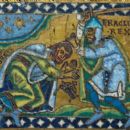 0
0
 0
0
rank #4 ·
Peter the Patrician (Latin: Petrus Patricius, Greek: Πέτρος ὁ Πατρίκιος, Petros ho Patrikios; c.–565) was a senior Byzantine official, diplomat, and historian. A well-educated and successful lawyer, he was repeatedly sent as envoy to Ostrogothic Italy in the prelude to the Gothic War of 535–554. Despite his diplomatic skill, he was not able to avert war, and was imprisoned by the Goths in Ravenna for a few years. Upon his release, he was appointed to the post of magister officiorum, head of the imperial secretariat, which he held for an unparalleled 26 years. In this capacity, he was one of the leading ministers of Emperor Justinian I (r. 527–565), playing an important role in the Byzantine emperor's religious policies and the relations with Sassanid Persia; most notably he led the negotiations for the peace agreement of 562 that ended the 20-year-long Lazic War. His historical writings survive only in fragments, but provide unique source material on early Byzantine ceremonies and diplomatic issues between Byzantium and the Sassanids.
